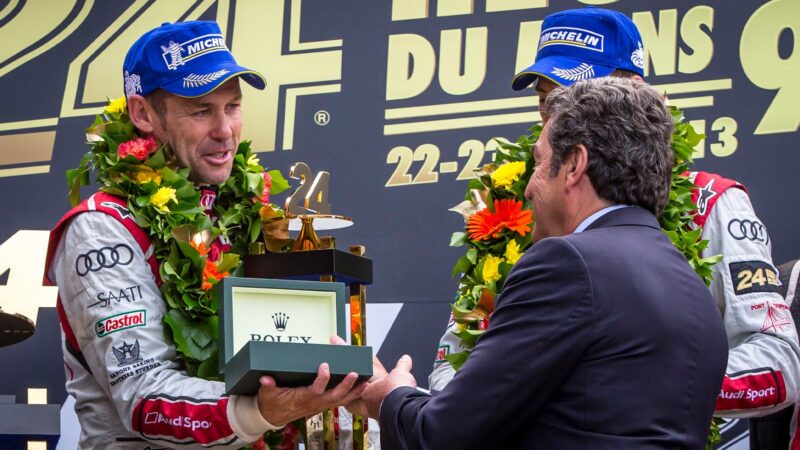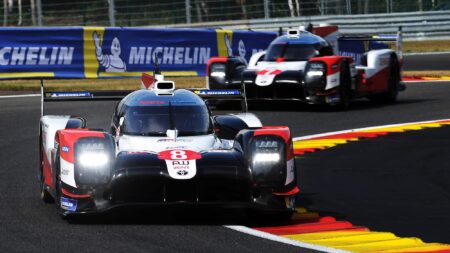It’s now six years since Tom took his final bow as a Le Mans driver, but this weekend he will be marking his 10th anniversary as a ‘Testimonee’ for luxury watch brand Rolex, which has been synonymous with the great endurance race for the past 20 years. “Rolex supports everything from the Daytona 24 Hours to the World Endurance Championship and Le Mans, and not only Formula 1 but Goodwood, Pebble Beach and Quail Lodge,” he says. “For me, that’s all the highlights of any motor racing season.”
Rolex keeps him busy, among other commitments such as his occasional stints as F1’s driver steward. The last time he was on duty was Monza, when Lewis Hamilton paid the stewards that visit during the red-flag delay to check on the 10-second stop-go penalty he’d incurred. We’ve got to ask – what did he say? “He knocked on the door,” is all Tom will say with a smile, acknowledging Hamilton’s courtesy. “He understood what happened, he took responsibility.”
Back to Le Mans. As it will be for all of us, this weekend will be very different for the race’s most successful driver. “It’s the first time since 1997 that I won’t be there,” he says. “I will enjoy Le Mans from home, in my own garage. I have invited some people who have supported me over the years, who only ever used to hear a few grumpy sentences from me during the race, and we will watch it from here. I will take part in the BBQ, the burgers – and maybe the third ‘B’ will be involved!”

With nine overall victories to his name, Kristensen is the most successful Le Mans driver in history
Rolex/Jad Sherif
He admits to some envy over the new Hyperpole qualifying session that will finalise the grid. Just 30 minutes long and running on Friday morning, the top six from each of the four classes will have a relatively clear track to go for times, within a condensed weekend schedule that will make this Le Mans even tougher than usual for the hard-working teams. “The build-up now is more extreme because you have less time,” says Tom. “You have the Hyperpole on Friday, which is normally a rest day for the drivers and a build-up day for the teams. The schedule now is not easy, maybe even more complex.
“But the Hyperpole is something I would have dreamt of. This is unexpected to hear from a Dane, but I would even have paid money to have a Hyperpole, to have some laps where you could only blame yourself or your set-up, not running into traffic, which can be very frustrating and risky but has always been a part of Le Mans. In Hyperpole, you still have to take risks, but at least you can say ‘there you go, this is what we can do’. Then again, a few hours into the race no one will probably remember.”
Kristensen and his fellow Danes will pay particular attention this weekend to the GTE Pro battle, as World Endurance Championship GT points leaders Marco Sørensen and Nicki Thiim, sharing with quick Brit Richard Westbrook, head the Aston Martin charge against Ferrari and Porsche, whose line-up includes fellow Dane and title rival Michael Christensen. But in LMP1, with only five cars on the entry, what sort of race can we expect? From past experience, we know the two Toyota Hybrid TS050s should be free to race, and the pair of non-hybrid privateer Rebellions, winners of two WEC rounds this season, should give the Japanese giant a headache or two. But it’s far from the most juicy of prospects, especially in comparison to the days when Toyota faced Audi and Porsche.

Kristensen battled Porsche and Toyota in the Audi R18
Jean Michel Le Meur / DPPI
That makes little difference to Kristensen, who points out Toyota’s crews face the same challenge of every driver who journeys to the Circuit de la Sarthe. “Le Mans is the most intense focus you have all year,” he says. “You focus on little things to minimise performance loss and mistakes. It doesn’t really matter who you race, everyone has their own inner pressure to do well. If anything this year, the pressure is on the engineers and mechanics probably even more than on the drivers, because the cars are so complex.”
Next year, who knows what the Le Mans entry will look like with so much uncertainty about the new Hypercar class? Just this week Alpine announced a plan to enter a ‘grandfathered’ Rebellion R-13 LMP1 to take on however many Hypercars turn out – so end-of-the-era talk is perhaps a little premature. Still, officially, the focus will shift from a category that has existed in some shape or form since the end of Group C in the early 1990s.
LMP1 is Kristensen’s era, but he has never been one to pick out a single car or year from his incredible roster of Le Mans successes. “I look back at the development over the years rather than one era,” he says. “My first Le Mans was in the Joest Porsche WSC95 [in ’97, his first victory], then I had the BMW for a couple of years, then on to the Audi R8. Those were the years when I probably had more input in car development. The BMW V12 LMR, the one they did with Williams, I was very much a part of that car. That’s why it hurt when we lost Le Mans in 1999. OK, we won our first race with it at the Sebring 12 Hours, but at Le Mans we had a four-lap lead when we retired on Sunday morning. But at least our sister car won.



